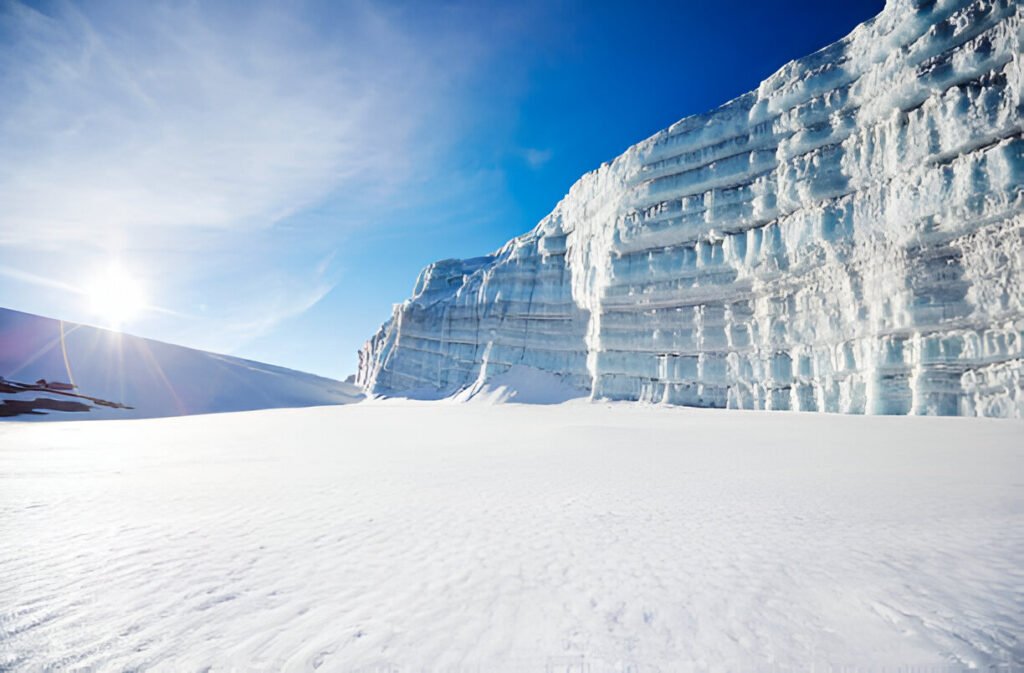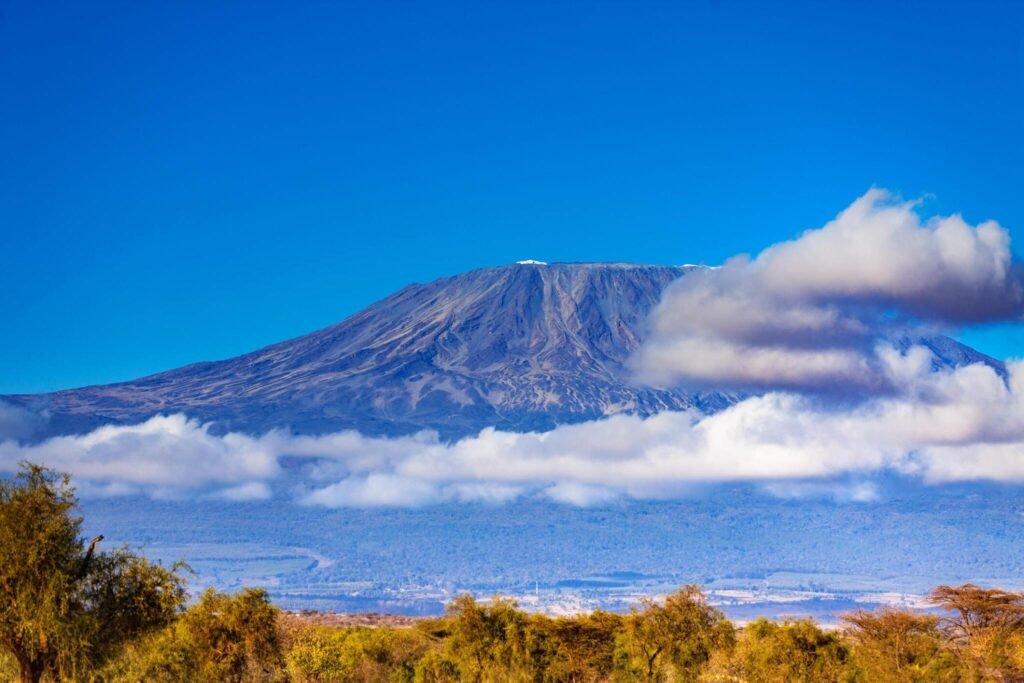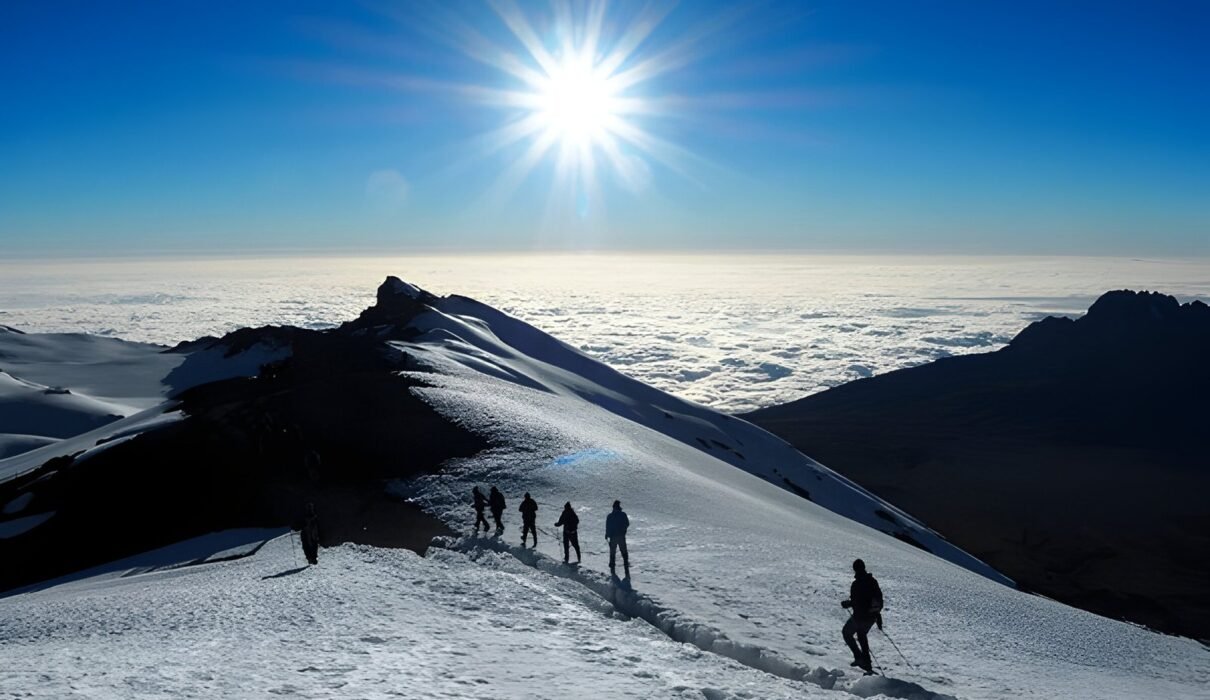Climbing Kilimanjaro in January : Mount Kilimanjaro, the highest peak in Africa, is a must-climb for adventurers and nature lovers. January is one of the best months to ascend this majestic mountain, offering favorable weather, clear skies, and an overall fantastic trekking experience. Whether you’re aiming to challenge yourself or enjoy the stunning landscapes, climbing Kilimanjaro in January provides a perfect balance of excitement and serenity.
In this guide, we’ll explore why January is an excellent time to climb, the best routes to take, the necessary gear, training tips, and much more.

Climbing Kilimanjaro in January : Why Climb in January ?
Choosing the right time to climb Kilimanjaro is crucial for ensuring a successful summit. January falls within the dry season, making it one of the best times to climb for many reasons:
1. Dry Weather and Clear Skies
January marks the beginning of the dry season on Kilimanjaro, which means climbers can expect less rain and clearer skies, especially in the early mornings and evenings. This allows for breathtaking views of the surrounding landscape and a more comfortable ascent.
2. Moderate Crowds
While January is popular for trekking, the crowds are moderate compared to other peak months like July or August. This provides a balance of having enough trekkers for camaraderie but not too many to make the trails overcrowded.
3. Beautiful Scenery
The lower slopes of Kilimanjaro are green and lush, thanks to the previous short rainy season. The landscapes are fresh, and the mountain offers its best views with clear skies during this period.
4. Perfect Temperatures
During the day, temperatures at the base of the mountain are mild, making the trek up the lower slopes comfortable. As you ascend, the temperatures drop, but the January weather still offers a great balance between warmth in the lower areas and manageable cold near the summit.
Check Out Kilimanjaro Climbing Options Here
Climbing Kilimanjaro in January : Best Kilimanjaro Routes for January Climbs
Kilimanjaro offers several routes to the summit, each with its own advantages and challenges. In January, certain routes stand out due to the favorable weather conditions and the trekking experience they offer.
1. Machame Route
Known as the “Whiskey Route,” the Machame Route is one of the most scenic and popular routes on Kilimanjaro. It offers a good mix of beautiful landscapes, including rainforests, moorlands, and high alpine deserts. Machame also provides a gradual ascent, allowing trekkers to acclimatize better
2. Lemosho Route
The Lemosho Route is perfect for those seeking a quieter and more remote experience. This route joins Machame halfway up and offers stunning panoramic views. It’s a longer route, which increases your chances of proper acclimatization and summit success.
3. Rongai Route
If you’re looking for the driest option in January, the Rongai Route is ideal. Starting from the northern side of Kilimanjaro, this route is less affected by the rains, providing drier trekking conditions. It’s also one of the quieter routes, offering solitude and a unique view of the mountain.
Explore Kilimanjaro’s Best Routes Here

Climbing Kilimanjaro in January – Weather in January: What to Expect
The weather on Kilimanjaro varies greatly depending on altitude. Here’s a breakdown of what you can expect at different elevations in January:
1. Base to 3,000 Meters (Rainforest Zone)
At the lower altitudes, temperatures are mild, ranging from 15°C to 24°C (59°F to 75°F). The weather is generally dry, but early mornings may feel cooler. You’ll trek through lush rainforests with minimal rainfall during this time.
2. 3,000 to 4,000 Meters (Moorland Zone)
In the moorland zone, temperatures drop to between 5°C and 15°C (41°F to 59°F). The weather remains clear with beautiful sunny days, but the nights start to get colder.
3. 4,000 to 5,895 Meters (Summit Zone)
At higher altitudes, especially near the summit, temperatures can drop to below freezing (-10°C to -20°C or 14°F to -4°F). Clear skies often reward climbers with panoramic views, but you’ll need to be prepared for icy winds and snowy conditions at the top.
Plan Your Climb with Eddy Tours Safaris
Climbing Kilimanjaro in January : Essential Gear for Climbing Kilimanjaro in January
Packing the right gear is essential for a successful summit, especially in January when weather conditions can vary dramatically with altitude. Here’s a checklist of the must-have items:
1. Layered Clothing
Temperatures fluctuate as you ascend, so it’s important to dress in layers. Start with moisture-wicking base layers, add insulating mid-layers, and finish with waterproof and windproof outer layers
2. Waterproof Jacket and Pants
While January is part of the dry season, it’s always possible to encounter some rain in the rainforest zone or snow at higher altitudes. Make sure your gear is fully waterproof to stay dry and comfortable.
3. Sturdy Hiking Boots
Bring waterproof hiking boots with good ankle support. The terrain on Kilimanjaro is rough and uneven, so you’ll need reliable footwear to protect your feet and provide stability.
4. Warm Gloves, Hat, and Socks
As you get closer to the summit, the temperatures drop significantly. Insulated gloves, a warm hat, and woolen socks are crucial for staying warm in freezing conditions
Climbing Kilimanjaro in January : Training for Your January Kilimanjaro Climb
Preparing for Kilimanjaro is not just about having the right gear. You’ll also need to train your body for the physical demands of the trek. Here are some key areas to focus on
1. Cardiovascular Endurance
Kilimanjaro is a long, multi-day trek, so your cardiovascular fitness needs to be in top form. Include activities like running, hiking, swimming, or cycling in your training routine.
2. Strength Training
Strengthening your legs and core is essential for handling the steep inclines and uneven terrain. Incorporate squats, lunges, and core exercises into your workouts.
3. Altitude Acclimatization
Climbing Kilimanjaro means dealing with high altitudes. If possible, practice hiking or trekking at higher altitudes before your trip to help your body acclimatize.
Find More Kilimanjaro Climbing Tips Here
Climbing Kilimanjaro in January : Frequently Asked Questions (FAQs)
1. Is January a good time to climb Kilimanjaro?
Yes, January is one of the best months to climb Kilimanjaro due to the dry weather, clear skies, and moderate temperatures.
2. What is the weather like on Kilimanjaro in January?
In January, the lower altitudes are mild and dry, while temperatures drop significantly near the summit. You can expect clear skies and beautiful views.
3. Which Kilimanjaro route is best for January?
The Machame, Lemosho, and Rongai routes are popular choices for January climbs. Each offers unique landscapes and trekking experiences, but all are suitable for this time of year
4. Do I need to be an experienced climber to summit Kilimanjaro in January?
No, Kilimanjaro is a non-technical climb, meaning you don’t need climbing experience. However, good physical fitness is necessary to handle the altitude and long days of trekking.
5. What gear do I need for climbing Kilimanjaro in January?
You’ll need layered clothing, a waterproof jacket, sturdy hiking boots, and warm gloves, hats, and socks to handle the varying temperatures and weather conditions.
6. How do I prepare for altitude on Kilimanjaro?
It’s important to take it slow on the mountain, allowing your body time to acclimatize. You can also train by hiking at high altitudes before your trip
Climbing Kilimanjaro in January : Start Your Kilimanjaro Adventure This January!
Climbing Kilimanjaro in January is an excellent choice for those seeking favorable weather, stunning views, and a challenging yet rewarding experience. Whether you’re looking to reach the summit or enjoy the journey through Kilimanjaro’s diverse ecosystems, January is the perfect time to take on Africa’s tallest mountain.
Book Your Climb Now with Kilimanjaro Climb Specialist
Discover More with Eddy Tours Safaris

